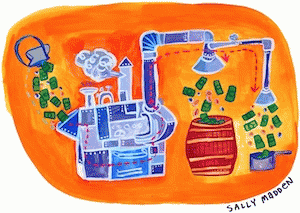Many authorities have said it: banks do not lend their deposits. They create the money they lend on their books.
Robert B. Anderson, Treasury Secretary under Eisenhower, said it in 1959:
When a bank makes a loan, it simply adds to the borrower's deposit account in the bank by the amount of the loan. The money is not taken from anyone else's deposits; it was not previously paid in to the bank by anyone. It's new money, created by the bank for the use of the borrower.
The Bank of England said it in the spring of 2014, writing in its quarterly bulletin:
The reality of how money is created today differs from the description found in some economics textbooks: Rather than banks receiving deposits when households save and then lending them out, bank lending creates deposits.
. . . Whenever a bank makes a loan, it simultaneously creates a matching deposit in the borrower's bank account, thereby creating new money.
All of which leaves us to wonder: If banks do not lend their depositors' money, why are they always scrambling to get it? Banks advertise to attract depositors, and they pay interest on the funds. What good are our deposits to the bank?
The answer is that while banks do not need the deposits to create loans, they do need to balance their books; and attracting customer deposits is usually the cheapest way to do it.
Reckoning with the Fed
Ever since the Federal Reserve Act was passed in 1913, banks have been required to clear their outgoing checks through the Fed or another clearinghouse. Banks keep reserves in reserve accounts at the Fed for this purpose, and they usually hold the minimum required reserve. When the loan of Bank A becomes a check that goes into Bank B, the Federal Reserve debits Bank A's reserve account and credits Bank B's. If Bank A's account goes in the red at the end of the day, the Fed automatically treats this as an overdraft and lends the bank the money. Bank A then must clear the overdraft.
Attracting customer deposits, called "retail deposits," is a cheap way to do it. But if the bank lacks retail deposits, it can borrow in the money markets, typically the Fed funds market where banks sell their "excess reserves" to other banks. These purchased deposits are called "wholesale deposits."
Note that excess reserves will always be available somewhere, since the reserves that just left Bank A will have gone into some other bank. The exception is when customers withdraw cash, but that happens only rarely as compared to all the electronic money flying back and forth every day in the banking system.
Borrowing from the Fed funds market is pretty inexpensive -- a mere 0.25% interest yearly for overnight loans. But it's still more expensive than borrowing from the bank's own depositors.
Squeezing Smaller Banks: Controversy Over Wholesale Deposits
That is one reason banks try to attract depositors, but there is another, more controversial reason. In response to the 2008 credit crisis, the Bank for International Settlements (Basel III), the Dodd-Frank Act, and the Federal Reserve have limited the amount of wholesale deposits banks can borrow.
(Note: You can view every article as one long page if you sign up as an Advocate Member, or higher).






